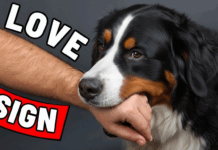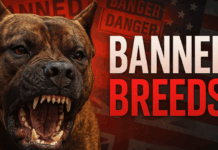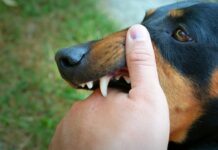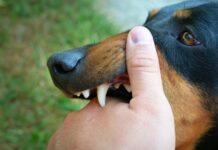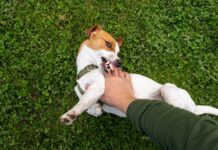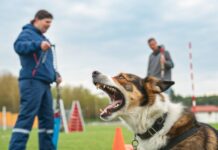Last Updated on May 15, 2024 by Dogs Vets
Understanding The Meanings Behind Common Dog Behaviors!
Our furry companions can’t exactly tell us what’s on their minds, but their body language speaks volumes. From the enthusiastic wag of a tail to the furrowed brow of a confused pup, understanding canine communication is key to building a strong and fulfilling bond with your dog.
Decoding the Wag:
Let’s start with the classic canine expression: the tail wag. We all know a wagging tail usually signifies happiness, but did you know the speed, direction, and intensity of the wag offer even more clues? A high, fast wag held proudly indicates excitement, while a slow wag held low might signal uncertainty or submission.
A tail held stiff and wagging can suggest nervousness or dominance, while a tucked tail between the legs screams fear or anxiety.
The Power of Play:
Playtime isn’t just fun for your dog; it’s an essential part of their development and well-being. Watch how your pup positions their body during playtime.
A play bow, with their front paws down and rear end in the air, is a universal canine invitation to a playful romp. Pouncing, barking with glee, and nipping (not biting!) at toys are all signs your dog is having a blast.
Beware the Body Language of Fear:
Understanding the signs of fear in dogs is crucial to prevent unwanted reactions. Flattened ears, tucked tails, whale eyes (where the whites of the eyes are visible), and growling are all warnings that your dog feels threatened.
If you see these signs, remove your dog from the situation and address the source of their fear calmly.
Calming Signals and Appeasement Gestures:
Don’t mistake appeasement gestures for submission. These subtle signals, like yawning, lip-licking, or averting gaze, are a dog’s attempt to de-escalate a potentially tense situation. Recognizing these signals can help you avoid inadvertently pushing your dog towards aggression.
The Sniff Test: Decoding Canine Communication
Dogs rely heavily on scent to navigate their world. Sniffing other dogs’ rear ends isn’t just a quirky habit; it’s a way for them to gather information. This exchange of “olfactory calling cards” allows dogs to learn about each other’s age, sex, and health status.
Next time you see your dog sniffing another pup, remember they’re simply exchanging greetings and gathering intel!
Understanding Your Dog’s Vocalizations
While we may not speak fluent “woof,” understanding the different vocalizations dogs use can help you decipher their moods. A happy bark sounds different from an alarmed bark.
Whining can indicate anything from boredom to pain, while growling is a clear sign your dog feels threatened. Pay attention to the context and the overall body language to accurately interpret your dog’s vocalizations.
Marking Their Territory:
Marking territory is a natural instinct for dogs. They may use urine, feces, or even scratching the ground to leave their scent and claim an area as their own. While this behavior can be frustrating indoors, understanding the motivation behind it can help you implement effective training techniques.
Destructive Behavior? Communication Breakdown
Scratching furniture, chewing shoes, or digging in the yard can be destructive behaviors, but they’re often rooted in communication. Is your dog bored and lacking stimulation? Anxious and lacking proper outlets for their energy? Addressing the underlying cause is key to curbing destructive behaviors.
Beyond the Basics: Less Common Signals
Canine communication goes beyond the tail wag and the bark. A furrowed brow can indicate confusion, while a relaxed posture with a soft belly exposed signifies ultimate trust and comfort. Learning these subtler signals will deepen your understanding of your furry friend.
Building a Bond Through Communication
By taking the time to understand your dog’s body language and vocalizations, you’ll be well on your way to building a strong and fulfilling bond. Remember, communication is a two-way street.
Pair your newfound knowledge of canine communication with clear, consistent training methods to create a harmonious relationship with your dog.
FAQs:
1. Why does my dog lick my face?
Licking is a natural canine behavior used for affection, grooming, and appeasement. Your dog might be showing you love, trying to calm you down, or simply seeking attention.
2. Why does my dog roll over on their back when I approach them?
Rolling over exposes a dog’s most vulnerable area, the belly. This is typically a sign of submission and trust. However, some dogs might roll over playfully, inviting belly rubs. Read your dog’s body language for the full picture.
3. How come my dog stares at me?
Staring is a common canine behavior with multiple meanings depending on the context.
- Love and Affection: A soft stare with relaxed body language and a gentle tail wag likely signifies love and adoration. Think of it as your dog giving you puppy dog eyes!
- Seeking Attention: Is your dog staring intently while holding a toy or following you around? They’re probably hoping for some playtime or a cuddle session.
- Confusion: A tilted head and a soft stare might indicate your dog is confused about something you said or did. Pay attention to your commands and ensure they’re clear and consistent.
- Waiting for Instruction: During training, a focused stare often means your dog is waiting for their next cue.They’re eager to please and want to know what to do next.
4. My dog groans a lot. Should I be worried?
Dog groans can have a variety of meanings. A relaxed groan during belly rubs often signifies contentment. However,groans coupled with pacing or licking their lips might indicate anxiety or pain. Consider your dog’s overall demeanor and consult a veterinarian if you’re concerned.
5. Why does my dog chase its tail?
Tail chasing can be a normal puppy behavior as they learn about their bodies. However, excessive tail chasing in adult dogs could indicate boredom, anxiety, or underlying medical conditions. Provide your dog with plenty of mental and physical stimulation to curb this behavior.
6. My dog scoots their rear end on the ground. What does it mean?
Scooting is a sign your dog’s anal glands are irritated or impacted. These glands are located near their rectum and release a strong scent. Scooting is an attempt to relieve the discomfort. Consult your veterinarian if scooting is accompanied by licking, redness, or difficulty defecating.
7. How can I help my dog with separation anxiety?
Separation anxiety manifests in various ways, including whining, barking, or destructive behavior when left alone.Desensitize your dog gradually by leaving for short periods and rewarding calm behavior upon your return.
Provide plenty of exercise and mental stimulation before leaving them alone. In severe cases, consult a professional animal behaviorist for personalized strategies.
Remember, every dog is an individual, and their communication style can vary.
By observing your dog’s body language, vocalizations, and behaviors in different situations, you’ll become an expert in deciphering their unique way of communicating. This newfound knowledge will strengthen your bond and create a lifetime of mutual understanding and love.
Fact Check
We strive to provide the latest valuable information for pet lovers with accuracy and fairness. If you would like to add to this post or advertise with us, don’t hesitate to reach us. If you see something that doesn’t look right, contact us!

